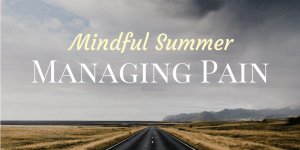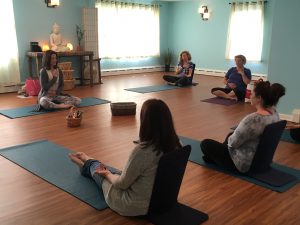
Disclaimer: This content is not intended to be a substitute for professional medical advice, diagnosis, or treatment. Always seek the advice of your physician or other qualified health provider with any questions you may have regarding a medical condition. Never disregard professional medical advice or delay in seeking it because of this article.
My Personal Story
It took me by surprise: I acquired three herniated discs in my lower back. I didn’t know how it happened – I had always been very active – I was a competitive high school athlete on the swim and tennis teams, a gymnast and dancer, and an aerobics instructor in my 20’s.
Most people will experience pain, to some degree, at some point in their lives. Many live with their pain on a daily basis. Pain can be the result of an accident, injury, illness, overuse, stress, or fatigue. It can be severe, mild, moderate, acute, intermittent, chronic, and have exacerbations and remissions.
My back pain was debilitating and it took me on a ten year journey to discover how to live with and manage pain – with mindfulness. This week, I’m sharing what I’ve learned on this journey and 6 mindful skills you can try to help you manage your pain.
Living with Pain
I discovered my herniated discs almost 20 years ago, after having my three children. I was so busy with the boys, all under the age of four, that I didn’t want to believe I may need to change my lifestyle. Leaning on my training as an Occupational Therapist, I was aware of and tried many “typical” remedies to help “deal” with the pain when my back would spasm, but they all seemed like Band-Aids. Nothing truly helped me to keep up with my pace and avoid future spasms.
More than 1.5 billion people worldwide suffer from chronic pain.
When was the last time you experienced pain? More than 1.5 billion people worldwide suffer from chronic pain. According to a recent report from the American Academy of Pain Medicine, the most common chronic pain complaints include: lower back pain, headaches, arthritis, cancer pain, and neurogenic pain (pain resulting from damage to the peripheral nerves). People lose sleep, miss work, limit their activities, and avoid social engagements due to their pain. Healthcare costs related to pain are increasing each year, and prescription pain medications are also on the rise. It’s important we find and try healthy ways to manage our pain.
Thinking back, I can remember getting impatient and a little snippy around holiday time. The relatives were coming to visit and stay for a few days, and there was so much to get done. I was having trouble standing at the kitchen counter to cook meals and bake cookies, and I couldn’t enjoy my family time. I worried, in anticipation of being out of commission for days. I thought, “I can barely walk. Who’s going to make the meals, take the kids to school and all their activities, and how will I work?” These thoughts were counterproductive as I tried to stretch, ice, heat, etc. to alleviate the pain.
Discovering Mindfulness
Although I had dabbled in yoga over the years, I never took the time to thoroughly understand, until I trained to become a certified instructor, that yoga is much more than poses. Together, mindfulness and yoga taught me new and more sustainable ways to manage my pain. As I now know, the problem could not be fully addressed by only working on my physical body.
My mind was interfering with my progress. I’d been living on autopilot – I was always in ‘doing mode.’ Finally I realized there was a strong disconnect between my mind and my body. I learned that I’d been oblivious to my body’s signals – it was actually shouting at me (in spasm and in pain) to stop and take care of myself.
When I discovered mindfulness, the practice taught me how to manage my pain rather than continue to allow the pain to manage me. Consequently, the muscle spasms actually occurred less frequently.
I also realized that I could be mindful throughout my day – checking in with my body (recognizing tension almost immediately), my emotions (my mood), and my thoughts (worrying, micro-managing my schedule). I had the ability, in these mindful moments, to release tension, let go of nagging thoughts, and even feel some peace throughout my day. I was no longer a prisoner to my pain, this was empowering!
Setting an Intention This Week
This week, set an intention to notice and listen to your body’s signals.
Pick an area of your body where you’d like to focus. This can be your lower back, your jaw, or any area that you might want to address. Throughout the week, listen to your body’s signals, begin to notice the first hint of tension/discomfort/pain, and then, in that moment, purposefully breathe, lengthen the exhale, and consciously relax the muscles in your body. Initially, it might help to schedule a phone reminder or a calendar event, 3 times/day, to help you remember to check-in.
6 Mindful Skills to Help Manage Pain
Here are six more ways to work with pain, if you have a more established practice:
- Listen to your body’s signals. Start to notice the first signs of tension building. I nipped that tension in the bud by relaxing my shoulders, focusing on and slowing down my breath, stretching, and/or adjusting my position. After time, my mind and body became more connected.
- Be more mindful of what you eat. Eat healthy and avoid foods that may increase your pain. I’ve learned what foods actually aggravate my back pain. For example: too much caffeine (including chocolate), alcohol, and dairy products, at times can exacerbate my symptoms.
- Use breath, gentle yoga, and visualization to soften your muscles around the pain. This may be achieved in any of the following ways:
- Breath: Take three slow and centering breaths – inhale for 4 seconds, hold for 2 seconds, exhale for 6 seconds.
- Yoga: Breathe into and out of some gentle yoga moves, hold each yoga pose for 3-4 full breaths.
- Visualization: Use imagery to aid in “seeing” the muscles and surrounding area begin to soften (melt) and allow the pain to dissipate.
- Develop a different relationship with your pain rather than run from it or fight it. Be gentle and compassionate. As Jon Kabat-Zinn has explained in his book, Full Catastrophe Living, Pain x Resistance = Suffering.
- Acknowledge, accept, and be with the pain. Notice more details about your pain experience (give it a color, shape, size, texture), breathe space into the painful area, and explore parts of your body that are without pain and are more relaxed. Learn to rest in the space where you feel most at ease.
- Routinely practice mindfulness. Maintain mind-body health. Stay deeply connected so you know your baseline and can be proactive to prevent setbacks. Set a ritual every morning and/or every evening to connect with yourself, deepen your breath, relax your body, and focus your mind on where you feel good. Soak in gratitude for all that your body is able to do for you each day.
It’s important to manage pain, one moment at a time, rather than worry about it lasting for hours, days, weeks, or months. You can endure anything for a moment.
Keep doing the things you love, even if you need to make modifications. You will begin to feel more engaged in your life and experience happy times, despite your pain. With mindfulness, we come to realize that whether pain originates physically, mentally, or emotionally, it’s always felt in the body and it can be managed in the same way.
Join Our Online LIVE Guided Practice on August 1st
We’re inviting our community to join Maria and the Mindful Schools Team for an online guided practice and short Q&A on Wednesday, August 1st at 4pm PST / 7pm EST. Maria will be leading the group through an expanded Body Scan mindfulness practice. RSVP here for more details. The recording is here:
About Maria

Maria’s enthusiasm for helping children lead more skillful, confident lives is revealed in her creative games and activities. You can read more about her story here.

